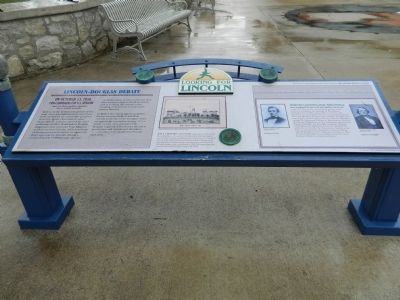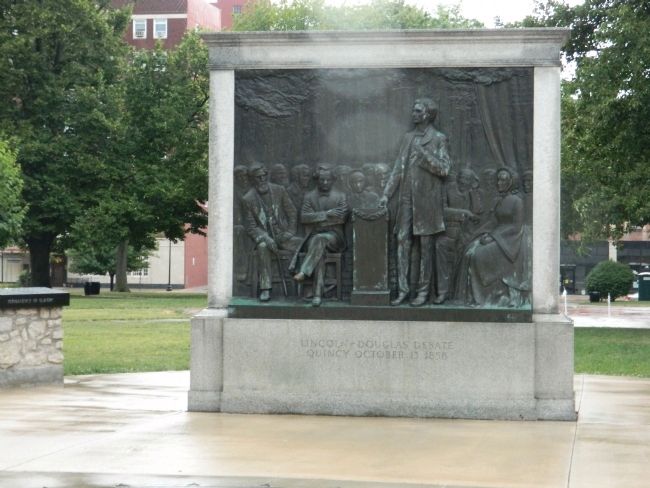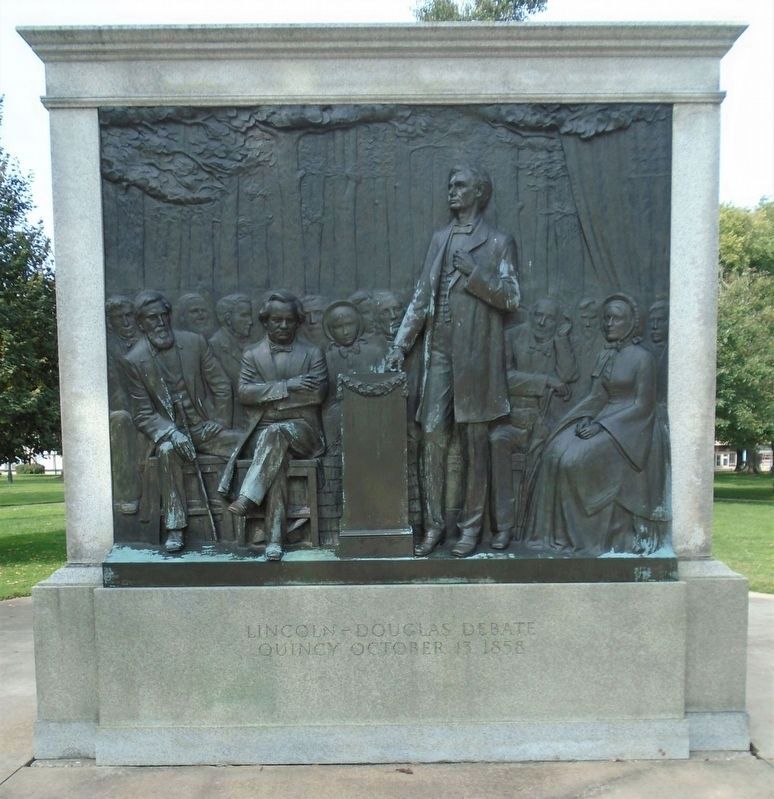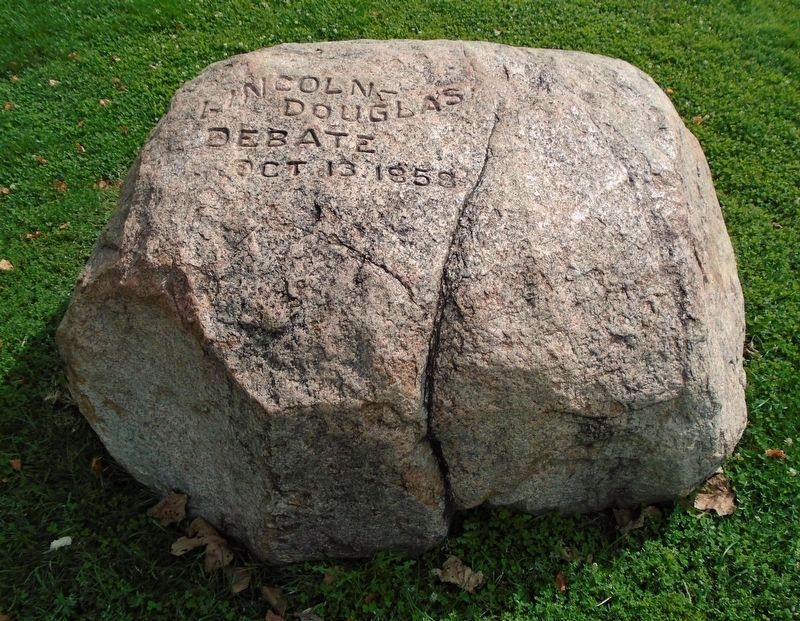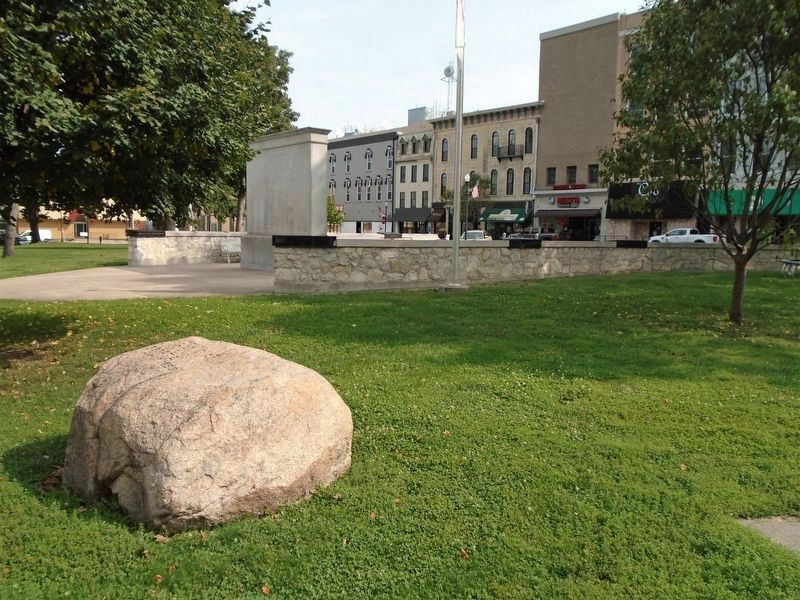Lincoln-Douglas Debate
Looking for Lincoln
On October 13 1858, two candidates for U.S. Senate met in this public square for a sixth debate. Quincy, in the west-central portion of the state, was a true battleground area where both candidates saw reasonable prospects of victory. Quincy had been Douglas' home district. Lincoln counted key local politicians as allies. Boatloads of Douglas supporters were recruited from Missouri to cheer on their favorite, while boatloads of Iowans traveled downriver to vigorously shout approval for Lincoln. Facing a crowd of nearly 15,000 people, the two candidates debated with intellectual rigor what American ought to do about slavery, and in so closely they examined the meaning of democracy to nineteenth century America.
In Quincy the moral argument against slavery was powerfully stated when Lincoln pronounced his strongest stand yet against the institution stating "it is a moral, a social, and a political wrong..." Douglas responded that slavery was not a moral issue and maintained that states "...can exist forever divided into free and slave states..."
Tall grasses covered the Square that was then enclosed by a double fence---the outer one a hitching rack for horses and wagons, with turnstiles to keep out roaming livestock, and the inner one a high board fence. In honor of the 150th Anniversary of the debate at Quincy, excerpts were engraved on the commemorative walls that now surround the Lorado Taft relief sculpture, which was dedicated in 1936. The six pairs of pro and con quotations focus on the issues central to the debate.
Lincoln was a successful lawyer whose political career encompassed four terms in the state legislature and one term in the U.S. House. He retired from politics after service in Congress, but passage of the Kansas-Nebraska Act of 1854 caused him to reverse that decision, as it permitted slavery in areas declared free since the Missouri Compromise of 1820. Douglas was running for a third term in the U.S. Senate. Douglas assisted by Quincyan William A. Richardson, Chair of the House Committee on the Territories, guided the Kansas-Nebraska Act through Congress. Popular sovereignty, the hallmark of the act, allowed the territories to decide for themselves whether to be free or slave and put Douglas in direct conflict with Republicans over expansion of slavery. This fundamental difference underscored the most famous debate in American history.
Erected by State of Illinois Historic Preservation Agency & Looking for Lincoln Heritage Coalition.
Topics and series. This historical marker is listed in this topic list: Government & Politics. In addition,
Location. 39° 55.953′ N, 91° 24.517′ W. Marker is in Quincy, Illinois, in Adams County. Marker is on North 5th Street, on the right when traveling east. Marker is in Washington Park. Touch for map. Marker is at or near this postal address: 122 N 5th St, Quincy IL 62301, United States of America. Touch for directions.
Other nearby markers. At least 8 other markers are within walking distance of this marker. Racial Equality (here, next to this marker); Lorado Taft (1860 - 1936) (here, next to this marker); Political Campaigning in 1858 (a few steps from this marker); Morality of Slavery (a few steps from this marker); Changing Slavery (a few steps from this marker); Dred Scott Decision (a few steps from this marker); Permanency of Slavery (a few steps from this marker); Spread of Slavery Into The Territories (a few steps from this marker). Touch for a list and map of all markers in Quincy.
Credits. This page was last revised on September 27, 2020. It was originally submitted on August 26, 2012, by Bill Pfingsten of Bel Air, Maryland. This page has been viewed 749 times since then and 32 times this year. Photos: 1. submitted on August 26, 2012, by Bill Pfingsten of Bel Air, Maryland. 2. submitted on May 15, 2020, by Jason Voigt of Glen Carbon, Illinois. 3. submitted on August 26, 2012, by Bill Pfingsten of Bel Air, Maryland. 4, 5, 6. submitted on September 27, 2020, by William Fischer, Jr. of Scranton, Pennsylvania.
